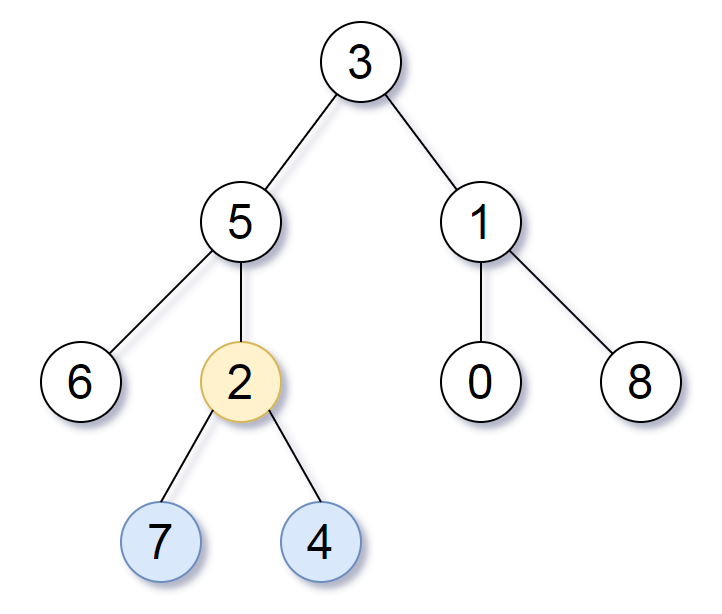Welcome to Subscribe On Youtube
865. Smallest Subtree with all the Deepest Nodes
Description
Given the root of a binary tree, the depth of each node is the shortest distance to the root.
Return the smallest subtree such that it contains all the deepest nodes in the original tree.
A node is called the deepest if it has the largest depth possible among any node in the entire tree.
The subtree of a node is a tree consisting of that node, plus the set of all descendants of that node.
Example 1:

Input: root = [3,5,1,6,2,0,8,null,null,7,4] Output: [2,7,4] Explanation: We return the node with value 2, colored in yellow in the diagram. The nodes coloured in blue are the deepest nodes of the tree. Notice that nodes 5, 3 and 2 contain the deepest nodes in the tree but node 2 is the smallest subtree among them, so we return it.
Example 2:
Input: root = [1] Output: [1] Explanation: The root is the deepest node in the tree.
Example 3:
Input: root = [0,1,3,null,2] Output: [2] Explanation: The deepest node in the tree is 2, the valid subtrees are the subtrees of nodes 2, 1 and 0 but the subtree of node 2 is the smallest.
Constraints:
- The number of nodes in the tree will be in the range
[1, 500]. 0 <= Node.val <= 500- The values of the nodes in the tree are unique.
Note: This question is the same as 1123: https://leetcode.com/problems/lowest-common-ancestor-of-deepest-leaves/
Solutions
-
/** * Definition for a binary tree node. * public class TreeNode { * int val; * TreeNode left; * TreeNode right; * TreeNode() {} * TreeNode(int val) { this.val = val; } * TreeNode(int val, TreeNode left, TreeNode right) { * this.val = val; * this.left = left; * this.right = right; * } * } */ class Solution { public TreeNode subtreeWithAllDeepest(TreeNode root) { return dfs(root).getKey(); } private Pair<TreeNode, Integer> dfs(TreeNode root) { if (root == null) { return new Pair<>(null, 0); } Pair<TreeNode, Integer> l = dfs(root.left); Pair<TreeNode, Integer> r = dfs(root.right); int d1 = l.getValue(), d2 = r.getValue(); if (d1 > d2) { return new Pair<>(l.getKey(), d1 + 1); } if (d1 < d2) { return new Pair<>(r.getKey(), d2 + 1); } return new Pair<>(root, d1 + 1); } } -
/** * Definition for a binary tree node. * struct TreeNode { * int val; * TreeNode *left; * TreeNode *right; * TreeNode() : val(0), left(nullptr), right(nullptr) {} * TreeNode(int x) : val(x), left(nullptr), right(nullptr) {} * TreeNode(int x, TreeNode *left, TreeNode *right) : val(x), left(left), right(right) {} * }; */ using pti = pair<TreeNode*, int>; class Solution { public: TreeNode* subtreeWithAllDeepest(TreeNode* root) { return dfs(root).first; } pti dfs(TreeNode* root) { if (!root) return {nullptr, 0}; pti l = dfs(root->left); pti r = dfs(root->right); int d1 = l.second, d2 = r.second; if (d1 > d2) return {l.first, d1 + 1}; if (d1 < d2) return {r.first, d2 + 1}; return {root, d1 + 1}; } }; -
# Definition for a binary tree node. # class TreeNode: # def __init__(self, val=0, left=None, right=None): # self.val = val # self.left = left # self.right = right class Solution: def subtreeWithAllDeepest(self, root: TreeNode) -> TreeNode: def dfs(root): if root is None: return None, 0 l, d1 = dfs(root.left) r, d2 = dfs(root.right) if d1 > d2: return l, d1 + 1 if d1 < d2: return r, d2 + 1 return root, d1 + 1 return dfs(root)[0] -
/** * Definition for a binary tree node. * type TreeNode struct { * Val int * Left *TreeNode * Right *TreeNode * } */ type pair struct { first *TreeNode second int } func subtreeWithAllDeepest(root *TreeNode) *TreeNode { var dfs func(root *TreeNode) pair dfs = func(root *TreeNode) pair { if root == nil { return pair{nil, 0} } l, r := dfs(root.Left), dfs(root.Right) d1, d2 := l.second, r.second if d1 > d2 { return pair{l.first, d1 + 1} } if d1 < d2 { return pair{r.first, d2 + 1} } return pair{root, d1 + 1} } return dfs(root).first }